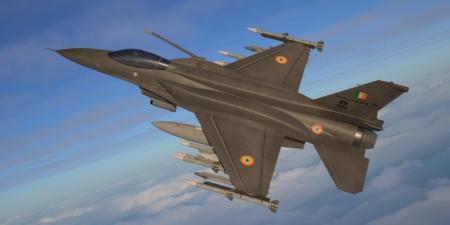Lockheed Martin’s F-21 (Or Super F-16) Won’t Be Joining India’s Air Force
Lockheed Martin is developing a new variant of its iconic F-16 single-engine fighter in order to compete in India’s 2019 tender for 110 new warplanes.
But don’t count on the American firm’s “F-21” to win the contract.
According to journalist Angad Singh, the likely winner is French company Dassault’s Rafale twin-engine fighter.
Singh explains his rationale in the May 2019 issue of Combat Aircraft magazine. India previously ordered 36 Rafales as part of an earlier fighter tender. “With 36 aircraft already on order and the infrastructure in place for an additional 36, a case could certainly be made that training, basing and sustainment costs for additional aircraft would not be an impossible burden.”
Other candidates for the Indian tender are the Saab Gripen from Sweden, the European Eurofighter Typhoon, the MiG-35 from Russia and the Boeing Super Hornet from the United States. Whichever fighter New Delhi selects, it needs the new jets now, according to Singh.
“The government-approved strength of the Indian Air Force, given the country’s well-publicized security scenario and the possibility of a ‘two-front’ threat of combined Pakistani and Chinese air action to the west and northeast, is 42 fighter squadrons,” Singh writes.
“There is little clarity on how this exact number was arrived at, but nonetheless, the IAF hasn’t come close to this strength for two decades, and has never approached anything near a force entirely equipped with modern aircraft.”
In 2019 the Indian air force maintains just 30 fighters squadrons. The units operate, among other plane types, 244 1960s-vintage MiG-21s and 84 MiG-27s that are only slightly younger. The MiG-21s, in particular, are accident-prone. Since the first of 874 MiG-21s entered Indian service in 1963, around 490 have crashed, killing around 200 pilots.
But the MiG-21s remain active. On Feb. 26, 2019 Indian planes crossed the line of control at India’s border with Pakistan and bombed what New Dehli described as a terrorist training camp near Balakot.
Several days of aerial fighting followed the bombing raid. On Feb. 27, 2019, Pakistani F-16s and other planes crossed the line of control to attack Indian forces, New Delhi claimed. Indian MiG-21s and other fighters intercepted the Pakistanis and shot down one plane, according to the Indian government.
The U.S. government reportedly counted Pakistan’s F-16s after the battle and concluded that none was missing, casting doubt on New Delhi’s claim.
Islamabad stated its forces shot down two Indian MiG-21s, but New Delhi copped to losing just one jet. Pakistani forces captured the MiG-21 pilot, Wing Commander Abhinandan Varthaman, and held him for two days before handing him over to Indian officials.
Now New Delhi wants to spend around $18 billion acquiring 110 new fighters to replace the old MiGs. The new planes would fly alongside European-designed Jaguars, French Mirage 2000s and Rafales, Russian MiG-29s and Su-30s and India’s own indigenous Tejas fighter in what Lockheed described as “the world’s largest fighter aircraft ecosystem.”
For the purposes of Lockheed’s marketing campaign, the F-21 is a new fighter, although it shares many of its major features with the F-16V the company has sold to Bahrain, Greece, Slovakia, South Korea and Taiwan. Lockheed can build new F-16Vs or upgrade older F-16s to the V-standard.
Still, renaming the F-16V isn’t only semantic. An F-16V or F-21 is a radically different warplane compared to the F-16A that first flew in 1978. The F-16A is a nimble, eight-ton fighter with an unsophisticated radar and short-range weapons. The F-16V weighs 10 tons, boasts a cutting-edge radar and other sensors and carries a wide array of long-range weaponry, all at the cost of maneuverability.
Lockheed initially implied India could follow an acquisition of F-21s with a separate purchase of the company’s F-35 stealth fighters.
“The F-21 has common components and learning from Lockheed Martin’s fifth-generation F-22 and F-35 and will share a common supply chain on a variety of components,” Lockheed stated on its website on the morning of Feb. 20, 2019.
A few hours later, that claim disappeared from the site. Despite Lockheed’s stealth tease, the French Rafale might be the frontrunner in the Indian fighter contest.
Appearing For SSB?? – Download The Best SSB Preparation Material
Also Read:
IAF officer achieves rare feat of 1,000 landings at Leh, Thoise
Army to equip Rudra and Apache Attack Copters with Fire-Control Radars
Kyrgyzstan women officers get training in OTA
Source: DefenceNews






 Order Now on Amazon
Order Now on Amazon
